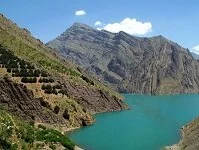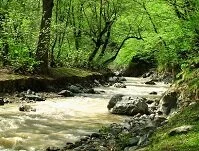Geography, Weather, & Wildlife of Iran
WARNING: International disputes with Iran are ongoing, please read this travel warning before going!
Geography

Lake in the mountains
Iran sits in the Middle East, stretching from Iraq and Turkey in the west to Afghanistan and Pakistan in the east; it is one of the largest countries in the Middle East by both size and population. Being such a large country, Iran has numerous land borders, including: Iraq to the west, Pakistan and Afghanistan to the east, Turkmenistan, Azerbaijan, and Armenia to the north, and Turkey to the northwest. The country also borders the Caspian Sea to its north and the Persian Gulf and Gulf of Oman to its south.
Iran is a very geographically diverse country. The central part of the country is a high dry plateau, while it is surrounded by mountains, which roughly make up the country's borders. These mountain ranges include the Elbrus Range in the northwest, the Khorasan Range in the east and the Baluchistan Range in the southeast among others. Although dry, the country is fairly livable due to the higher elevations and hence lower temperatures.
Weather

River in the forest
Iran has a significant number of mountains throughout their country, but the land also dips to lower elevations making the weather dependent on a number of things, most noticeably elevation and season. During winters (about November to March) the northwest mountains get very cold and can receive a significant amount of snow at elevation. This region can remain below freezing for much of December and January. The rest of the country is warmer and rarely dips to below freezing as this time of year is the rainy season, but again few places get much rain as most of it is concentrated in the northern mountains and along the Caspian Sea. Average temperatures in Tehran are about 45° F (7° C) during the winter. During summers (about June to August) temperatures peak in the southern part of Iran with average highs of about 100° F (38° C), although the rest of the country is cooler and Tehran averages about 80° F (27° C) during these months. In some areas the summers can also bring humidity, although most of the country is fairly dry during this season.